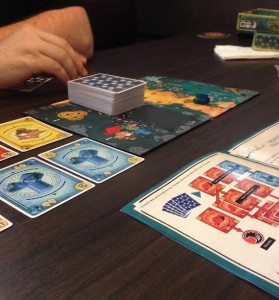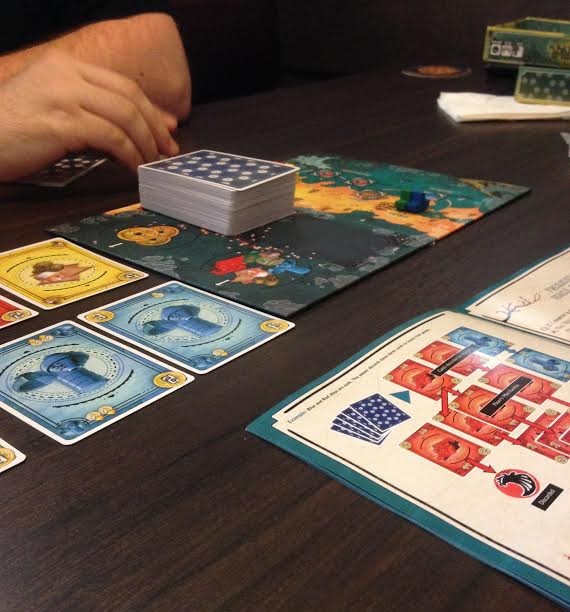This week’s Monday Night Gaming: Traders of Osaka.
 Publisher: Z-Man Games
Publisher: Z-Man Games
# of Players: 2-4 Players
Best with: 3 players
Playing Time: 1st time through, 1 hour+ depending on # of players. After that, 30-60 minutes.
# of Expansions: 0
# of Parts: Game board, rule book, 108 cards, 48 achievement tokens, 4 ships, 4 trader pieces, 4 reservation pieces.
After playing a round of Legendary, we wanted a short game to finish the day with. This game wasn’t as short as we thought it would be, but it filled the time nicely. In Traders of Osaka, players are merchants shipping goods from Alexandria to Carthage. The ships on the board move at a pace set by goods bought. Some areas on the board are safe, while others trigger tsunamis that destroy goods. Players are tasked with collecting sets of goods for victory points.
General Mechanics:
The general set up has the ships on the board while goods (via cards) are laid out across the Market and Farm. During a players turn, they can:
- buy goods (which means buying ALL the goods in the Market)
- get coins (which means taking 1 card from the Market to your hand–now it serves as money rather than a good)
- reserve a card (this is handy for tagging cards you can’t yet afford)
Each card has a money value that serves as how much it costs to buy the “good” and how much money it gives you if you take it as money rather than a good. The only way to get goods is to buy everything in the market. If a card has a reservation token on it, you can’t buy it (unless it’s your reservation token!). Players my find themselves needing 5 coins or 30 coins, depending upon the goods in the Market.
There is a strategy to buying goods and getting coins. High value goods give you more victory points, but taking the card as coins, lets you purchase more expensive markets.
Once you buy the goods, they are laid out in front of the player. The ships on the board move forward based on the number of cards purchased. Example–If you buy 3 blue goods and 2 green goods, the blue ship advances 3 spaces while the green ship advances two.
Once the market is purchased, the cards in the Farm move up to the market and other cards are dealt to fill the marketplace.
If a ship reaches Carthage, then a payout occurs in that color. Payout is a bit complicated the first time through, but it’s easy to pick up after that. Cards from payout end up in the players’ victory point stack for the end of the game. Example–If you have your 3 blue goods going to payout, you would look at the highest value in your blue cards. Let’s say the highest value is 3. You multiply five times the number of cards (3×3) and get 9. You then round up to the nearest 5, which is 10. Divide that by 5 and get 2. That means 2 cards go to your victory point pile.
At the end of payout, players who shipped goods and got paid receive an achievement token for the color scored. Achievement tokens are handy because they add to your multiplier. Let’s take the same example as above, but this time, you have 2 blue tokens. You would add 2 to the number of cards you have. That means this time, you’d multiply 3×5 and get 15. 15/5 is 3, so you get 3 cards in the victory pile instead.
Payout also triggers a tsunami. Any ships on those spaces are now in danger. For example, if the green ship were on the endangered space, players would need to “insure” their green goods or they would lose them. Cards in your hand which have the people icon are insurable. You can pay (discard) those cards from the hand to protect a certain number of goods on the table.
How to Win/Lose:
The game ends when a player has 8 or more achievement tokens. The winner is the player with the highest score (number of cards in your victory point pile). If there’s a tie, the tiebreaker is the number of achievement tokens a player has.
What I Liked:
I was surprised at how much strategy there is to this game. I wasn’t expecting it to go as long as it did or get as complicated as it did. I enjoyed playing it and want to play it again now that I understand the rules a bit better.
What I Didn’t Like:
The scoring seems a bit convoluted. I feel like there could be a better way to payout points…
Overall Rating/Impression:
It’s a seemingly simple game at its base with a serious kick of strategy to it. Fun and not too time consuming. 7/10.


